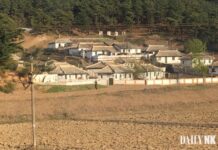[imText1]2009 is the “Year of the Ox,” according to the Chinese zodiac. To celebrate, North Korean state-owned broadcaster Chosun Central TV has introduced information on the customs and usage of cows in the country in a recently aired program called “Trivia on Cows.”
Ryu Man Hyuk, a researcher from the North Korean Academy of Social Sciences who appeared in the broadcast, announced, “Since times immemorial, our ancestors have raised cows and have used them as domesticated animals for farming and as a source of high-quality leather and meat.”
He continued, “Cows, animals that are used for difficult farm labor or for carrying materials over long-distances, are beloved for their strength and obedience.”
The broadcast also introduced the traditional “Day of the Cow.” It said, “There are several traditions surrounding cows. Particularly, one day is designated ‘the Day of the Cow;’ it is a day for maintaining ones cows, clean them, allow them to rest and feed them well. On this day, people feed cows beans and lay new straw mats to protect them against the cold. People clean the cow and its stable, too.” The precise day is designated according to the lunar calendar, and changes every year, but it is the first “cow day” of the 12-day Chinese zodiac cycle which falls after Chinese New Year’s Day.
The program also introduced traditional customs and games, including a traditional dance called ‘cow play,’ and cow fighting.
The program emphasized, “Such customs reflect our people’s industriousness; stressing the importance of maintaining domestic cows and stressing their role in meticulous farming. Even on farms nowadays, people are well aware that in order to increase grain yields and deal with labor issues, cows have to be well-maintained, so they continue to concentrate their efforts in this area.”
As seen in the program, most farm work in North Korea still utilizes cows. Thus, cows are considered an invaluable means of production in the country. They are property of the state and cannot be freely slaughtered by individuals.
In the case of the death or loss of a cow, one can be severely punished by not only the “cow maintenance guard,” but also the manager of a working group or even the chief of a sub-workers group (consisting of 15 to 20 farmers). Serious offenders can even be executed.
In point of fact, prior to the mid-1990s tractors were often used on farms. However, along with the “March of Tribulation in mid-1990s,” the use of tractors became less common due to a shortage of fuel and spare parts, so the traditional farming method of using cows had to be reintroduced.
In the period between 1995 and1999, cows being used to cultivate rice paddies and other fields, and even people ploughing in their place, were common sights on any North Korean farm. Agricultural practices in North Korea actually regressed back to those of the1960s.
About 10 years have passed since then, but in the North, cows are still mainly used in farming. With improving fuel supplies so tractors have reemerged, but the importance of cows to agricultural work has scarcely diminished.
















